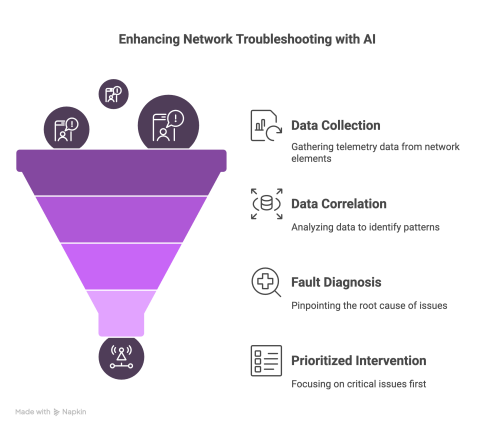Introduction
As cable providers continue to evolve their networks, operators can be met with confusing and potentially overwhelming use cases when it comes to implementing AI solutions. We sat down with our AI expert, Sahil Yadav, to explore the key areas where AI is projected to make a real impact.
Q: AI is a massive topic; can you share the top areas where operators should be thinking about AI?
A: Yes! AI certainly isn’t just a buzzword, it’s a practical, powerful tool that can reshape how cable operators manage and maintain their networks. If you look at the biggest challenges operators face—reliability, remediation, and operational cost, AI can offer solutions to help predict failures, detect faults automatically, and even assist field technicians in real-time, laying the groundwork for self-optimizing and autonomous network operations.
Q: How can cable operators prevent unplanned equipment failures using AI before they disrupt service?
A: Unplanned equipment failures, like node outages or amplifier degradation, can severely impact service and customer satisfaction. AI can tackle this with predictive network maintenance.
By analyzing historical performance and environmental data, AI models can forecast potential failures before they happen. This gives operators the opportunity to schedule proactive maintenance, avoiding emergency repairs.
Over the long term, it can reduce downtime, improve network reliability, and decrease operational costs by minimizing truck rolls.

Q: Is there a faster way with AI to detect and fix network faults than waiting for customer complaints?
A: Right now, many operators still rely on reactive troubleshooting, often triggered by customer complaints. This is where automated faultdetection and localization can come in and correlate data across multiple inputs and devices to uncover the root cause of issues.
AI can monitor concurrent telemetry data, like signal-to-noise ratio (SNR), modulation error ratio (MER), bit error rate (BER), power levels, tilt, latency, and temperature from network elements for faults including ingress noise, return path distortions, power fluctuations, overheating components, RF mismatches, and signal reflections. By automating correlation and diagnosis, operators can reduce these time-consuming tasks when done manually, increase diagnostic speed, and prioritize intervention more effectively, ultimately minimizing network disruption.
Q: How does AI enhance remote monitoring and asset management?
A: Remote management provides operators the ability to monitor and control network elements in real-time without rolling a truck. This means they can push firmware updates, adjust configurations, and diagnose faults remotely, reducing Mean Time to Repair (MTTR).
AI further enhances remote monitoring and asset management by building a dynamic, data-driven view of network element health and performance. By correlating performance anomalies across locations and devices, AI can identify underperforming or aging assets, predict end-of-life components, and inform just-in-time replacement strategies. This minimizes wasteful replacements, prioritizes capital investment, and ensures that infrastructure maintenance aligns with actual performance trends, not fixed schedules.
Q: How can AI help field technicians become more effective on-site?
A: Field technicians often face complex issues without access to all the data they need. With AI-powered mobile tools, technicians can get actionable insights before they even reach the site. On-site, AI can diagnose issues by way of analyzing a combination of local device logs, telemetry, and fault history to suggest the most likely root causes.
Taking it a step further, there’s also the opportunity to offer recommended fixes on the spot. More advanced implementations can include predictive guidance based on similar, past cases in the network. As a result, technicians not only receive real-time diagnostics but also priority next steps and recommended configuration changes, which can improve accuracy, reduce MTTR, and elevate the overall quality of field service.

Sahil Yadav is a senior director of product management at Applied Optoelectronics Solutions, Inc. and a recognized expert in AI-driven infrastructure. He has led the development of autonomous systems for Fortune 500 companies as well as government clients. With deep expertise in ML, telemetry, and network resilience, Sahil builds self-healing and compliant AI architectures across cloud, edge, and on-prem environments for predictive maintenance and infrastructure monitoring. A senior IEEE member, he is a frequent conference speaker, blog author, and media contributor.